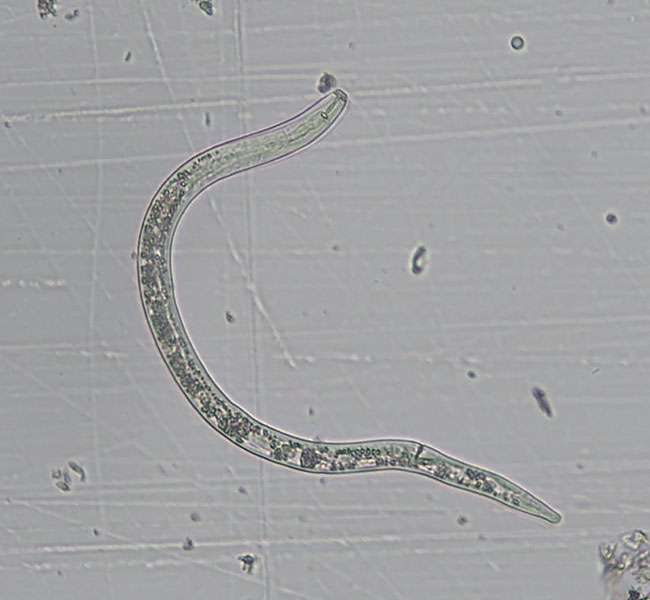
Features
Pest Management
Getting to the root of plant parasitic nematodes
Nova Scotia has launched a three-year project to examine plant parasitic nematodes in horticultural crops to provide producers with updated management practices for the region.
March 15, 2023 By Michelle Cortens and Matthew Peill, Perennia
 Close up of a root-lesion nematode as seen under a microscope.
Credit: Photo courtesy of Matthew Piell.
Close up of a root-lesion nematode as seen under a microscope.
Credit: Photo courtesy of Matthew Piell. Sometimes plants grow poorly. You know the plants we’re talking about. They’re stunted, growth is uneven throughout a production area, production is delayed, root systems are small, yield is low and some are dying. No obvious explanation exists aboveground. When the cause is belowground, in the soil, the issue can seem like a mystery.
Preliminary sampling has revealed a high population density of plant parasitic nematodes in horticultural crops. Nematodes are microscopic roundworms that feed on roots, causing direct damage. They also compromise roots by providing entry points to other soil-borne fungal and bacterial pathogens.
Recognizing the increasing threat of nematodes, the Nova Scotia Department of Agriculture partnered with Perennia Food and Agriculture to initiate a three-year project to determine the diversity and distribution of plant parasitic nematodes affecting horticultural crops in the province and develop and adapt management practices for the region. To do this, systematic nematode sampling is being performed across the province along with on-farm management trials.
The objective of systematic sampling is to map the presence of plant parasitic nematodes within Nova Scotia. Our goal is to collect over 200 samples from producers across the province, with 125 samples having already been collected throughout 2022. Initially, samples were sent to external labs for quantification, but now Perennia’s Plant Health Lab is performing nematode sample analysis.
Sampling is targeted for when nematodes are most active in spring and fall, when the average soil temperature Is between 10 and 20 C. In addition to the nematode population data, we are also collecting surveys on cropping history and management at each site to determine what practices may be affecting nematode populations.
Two major nematodes of concern in Nova Scotia are root-lesion and root-knot nematodes, which affect a wide variety of vegetable, berry and tree fruit crops. Root-lesion nematodes damage plants by entering and feeding on the cells of the root. As the nematodes move from cell to cell, the root tissue dies, leaving distinctive black lesions that are entry points for plant diseases.
Root-knot nematode females embed themselves in plant roots, causing galls to form, which impacts root function. Plant nutrients are diverted to the galls to feed the nematode as they swell with eggs that they then lay into the soil.
After systematic sampling is completed, we will have a better understanding of these nematodes and their relationships with different crops in Nova Scotia, as well as other plant parasitic nematodes.
Next, we aim to inform regional management practices by expanding our provincial extension knowledge. The decision to withdraw Pest Management Regulatory Agency (PMRA) registration of a broad-spectrum fumigant containing methyl bromide in Canada was followed by an emphasis on more environmentally sustainable chemistries and integrated management practices. The latest suggestions for preplant nematode management have not yet been tested in Nova Scotia’s unique climate, creating an opportunity to evaluate and recommend new strategies.
Research has shown that cover crops, such as certain species of mustards, sorghum-sudangrass and ryegrass, can kill root-knot and root-lesion nematodes, and pearl millet can be a poor host. Cover crops can also reduce soil-borne pathogens – a secondary cause of crop loss in fields with high nematode populations. We are evaluating the impact of such cover crops in select crops, including apple orchards and carrot and strawberry fields.
In the case of established perennial apple and strawberry crops, it’s too late for the benefits of cover crops. Few options exist to mitigate the damage caused by nematodes after crops have been established. However, we’ve recently gained access to Velum Prime, a newly registered nematicide which causes paralysis in plant parasitic nematodes. There are also reports of Movento offering nematocidal activity. We included the chemistries in our field trials to explore their efficacy. Both chemistries boast better safety for the user and environment than older chemistries.
To test the efficacy of the practices in our field trials, we took samples of soil and roots before and after treatments to evaluate for nematodes. Nematode populations can be hit-and-miss, so our samples were composed of a mixture of soil cores taken throughout the trial area.
Finally, we strive to improve our understanding of the nematode population in Nova Scotia, including the influence of fluctuations in soil temperature and moisture over the season. We chose two different land use situations to monitor that had known populations of root-lesion nematodes and root-knot nematodes. The sites, an established orchard and a green fallow site, were then sampled sequentially for nematodes. We hope to gain insights into the best times to sample and implement management practices.
An integrated approach to control parasitic nematode populations is needed for sustainable crop production. Solutions need to be effective and reliable for their widespread adoption. So, we’ve got our boots on the ground in search of management practices that reduce plant parasitic nematode populations.
Print this page